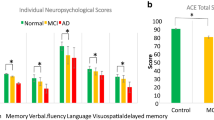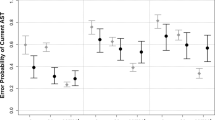Abstract
Patients with Alzheimer's disease have an impairment of inhibitory control for reasons that are currently unclear. Using an eye-tracking task (the gap-overlap paradigm), we examined whether the uncorrected errors relate to the task of attentional disengagement in preparation for action. Alternatively, the difficulty in correcting for errors may be caused by the working memory representation of the task. A major aim of this study was to distinguish between the effects of healthy aging and neurodegenerative disease on the voluntary control of saccadic eye movements. Using the antisaccade task (AST) and pro-saccade task (PST) with the ‘gap’ and ‘overlap’ procedures, we obtained detailed eye-tracking measures in patients, with 18 patients with probable Alzheimer's disease, 25 patients with Parkinson's disease and 17 healthy young and 18 old participants. Uncorrected errors in the AST were selectively increased in Alzheimer's disease, but not in Parkinson's disease compared to the control groups. These uncorrected errors were strongly correlated with spatial working memory. There was an increase in the saccade reaction times to targets that were presented simultaneously with the fixation stimulus, compared to the removal of fixation. This ‘gap’ effect (i.e. overlap–gap) saccade reaction time was elevated in the older groups compared to young group, which yielded a strong effect of aging and no specific effect of neurodegenerative disease. Healthy aging, rather than neurodegenerative disease, accounted for the increase in the saccade reaction times to the target that are presented simultaneously with a fixation stimulus. These results suggest that the impairment of inhibitory control in the AST may provide a convenient and putative mark of working memory dysfunction in Alzheimer's disease.




Similar content being viewed by others
References
Abel L, Troost B, Dell'Osso L (1983) The effects of age on normal saccadic characteristics and their variability. Vis Res 23:33–37
Amieva H, Phillips LH, Della Sala S, Henry JD (2004) Inhibitory functioning in Alzheimer's disease. Brain 127:949–964
APA (2000) Diagnostic and statistical manual of mental disorders. American Psychiatric Association, Washington
Baddeley A (2007) Working memory, thought and action. Oxford University Press, Oxford
Baddeley A, Hitch G (1974) Working memory. In: Bower G (ed) The psychology of learning and motivation: advances in research and theory. Academic, New York, pp 47–89
Boxer AL, Garbutt S, Rankin KP, Hellmuth J, Neuhaus J, Miller BL, Lisberger SG (2006) Medial versus lateral frontal lobe contributions to voluntary saccade control as revealed by the study of patients with frontal lobe degeneration. J Neurosci 26:6354–6363
Briand KA, Hening W, Poizner H, Sereno AB (2001) Automatic orienting of visuospatial attention in Parkinson's disease. Neuropsychologia 39:1240–1249
Broerse A, Crawford TJ, den Boer JA (2001) Parsing cognition in schizophrenia using saccadic eye movements: a selective overview. Neuropsychologia 39:742–756
Cameron IG, Watanabe M, Pari G, Munoz DP (2010) Executive impairment in Parkinson's disease: response automaticity and task switching. Neuropsychologia 48:1948–1957
Cameron IG, Pari G, Alahyane N, Brien DC, Coe BC, Stroman PW, Munoz DP (2012) Impaired executive function signals in motor brain regions in Parkinson's disease. NeuroImage 60:1156–1170
Castel AD, Balota DA, McCabe DB (2009) Memory efficiency and the strategic control of attention at encoding: impairments of value-directed remembering in Alzheimer's disease. Neuropsychology 23:297–306
Chambers J, Prescott T (2010) Response times for visually guided saccades in persons with Parkinson's disease: a meta-analytic review. Neuropsychologia 48:887–899
Chan F, Armstrong I, Pari G, Riopelle R, Munoz D (2005) Deficits in saccadic eye-movement control in Parkinson's disease. Neuropsychologia 43:784–796
Collette F, Schmidt C, Scherrer C, Adam S, Salmon E (2009) Specificity of inhibitory deficits in normal aging and Alzheimer's disease. Neurobiol Aging 30:875–889
Crawford TJ, Bennett D, Lekwuwa G, Shaunak S, Deakin JF (2002) Cognition and the inhibitory control of saccades in schizophrenia and Parkinson's disease. Prog Brain Res 140:449–466
Crawford TJ, Higham S, Renvoize T, Patel J, Dale M, Suriya A, Tetley S (2005) Inhibitory control of saccadic eye movements and cognitive impairment in Alzheimer's disease. Biol Psychiatry 57:1052–1060
Crawford TJ, Kean M, Klein RM, Hamm JP (2006) The effects of illusory line motion on incongruent saccades: implications for saccadic eye movements and visual attention. Exp Brain Res 173:498–506
Crawford TJ, Parker E, Solis-Trapala I, Mayes J (2011) Is the relationship of prosaccade reaction times and antisaccade errors mediated by working memory? Exp Brain Res 208:385–397
Crevits L, DeRidder K (1997) Disturbed striatoprefrontal mediated visual behaviour in moderate to severe parkinsonian patients. J Neurol Neurosurg Psychiatry 63:296–299
Crevits L, Vandierendonck A, Stuyven E, Verschaete S, Wildenbeest J (2004) Effect of intention and visual fixation disengagement on prosaccades in Parkinson's disease patients. Neuropsychologia 42:624–632
Duncan J, Emslie H, Williamms P, Johnson R, Freer C (1996) Intelligence and the frontal lobe: the organzation of goal-directed behaviour. Cogn Psychol 30:257–303
Eenshuistra RM, Ridderinkhof KR, van der Molen MW (2004) Age-related changes in antisaccade task performance: inhibitory control or working-memory engagement? Brain Cogn 56:177–188
Eenshuistra R, Ridderinkhof K, Weidema M, van der Molen M (2007) Developmental changes in oculomotor control and working-memory efficiency. Acta Psychol 124:139–158
Faust ME, Balota DA, Spieler DH, Ferraro FR (1999) Individual differences in information-processing rate and amount: implications for group differences in response latency. Psychol Bull 125:777–799
Fischer B, Weber H (1993) Express saccades and visual attention. Behav Brain Sci 16:553–610
Fischer B, Biscaldi M, Gezeck S (1997) On the development of voluntary and reflexive components in human saccade generation. Brain Res 754:285–297
Folstein M, Folstein S, McHugh P (1975) Mini-Mental State Examination. J Psychiatric Res 12:189–198
Fukushima J, Fukushima K, Miyasaka K, Yamashita I (1994) Voluntary control of saccadic eye movement in patients with frontal cortical lesions and parkinsonian patients in comparison with that in schizophrenics. Biol Psychiatry 36:21–30
Garbutt S, Matlin A, Hellmuth J, Schenk AK, Johnson JK, Rosen H, Dean D, Kramer J, Neuhaus J, Miller BL, Lisberger SG, Boxer AL (2008) Oculomotor function in frontotemporal lobar degeneration, related disorders and Alzheimer's disease. Brain 131:1268–1281
Greenwood PM, Parasuraman R, Alexander GE (1997) Controlling the focus of spatial attention during visual search: effects of advanced aging and Alzheimer's disease. Neuropsychology 11:3–12
Hallett P (1978) Primary and secondary saccades to goals defined by instructions. Vis Res 18:1279–1296
Hoehn M, Yahr M (1967) Parkinsonism: onset, progression and mortality. Neurology 17(5):427–442
Hutton SB, Ettinger U (2006) The antisaccade task as a research tool in psychopathology: a critical review. Psychophysiol 43:302–313
Kaufman LD, Pratt J, Levine B, Black SE (2010) Antisaccades: a probe into the dorsolateral prefrontal cortex in Alzheimer's disease. A critical review. J Alzheimers Dis JAD 19:781–793
Kaufman LD, Pratt J, Levine B, Black SE (2012) Executive deficits detected in mild Alzheimer's disease using the antisaccade task. Brain Behav 2:15–21
Kimberg D, Farah M (2000) Is there an inhibitory module in the prefrontal cortex? Working memory and the mechanisms underlying cognitive control. In: Monsell S, Driver J (eds) Attention and performance, vol. XVIII. MIT Press, Cambridge
Kingstone A, Klein R, Morein-Zamir S, Hunt A, Fisk J, Maxner C (2002) Orienting attention in aging and Parkinson's disease: distinguishing modes of control. J Clin Exp Neuropsychol 24:951–967
Kitagawa M, Fukushima J, Tashiro K (1994) Relationship between antisaccades and the clinical symptoms in Parkinson's disease. Neurology 44:2285–2289
Leigh R, Kennard C (2004) Using saccades as a research tool in the clinical neurosciences. Brain 127:460–477
Lueck CJ, Tanyeri S, Crawford TJ, Henderson L, Kennard C (1990) Antisaccades and remembered saccades in Parkinson's disease. J Neurol Neurosurg Psychiatry 53:284–288
Milner B (1971) Interhemispheric differences in the localization of psychological processes in man. British Medical Bulletin 27. Br Med Bull 27:272–277
Mitchell JP, Macrae C, Gilchrist ID (2002) Working memory and the suppression of reflexive saccades. J Cog Neurosci 14:95–103
Moschner C, Baloh RW (1994) Age-related-changes in visual tracking. J Gerontol 49:M235–M238
Munoz DP, Broughton JR, Goldring JE, Armstrong IT (1998) Age-related performance of human subjects on saccadic eye movement tasks. Exp Brain Res 121:391–400
Posner M, Cohen Y (1984) Components of visual orienting. In: Bouma H, Bouwhuis D (eds) Components of visual orienting, vol. 10. Erlbaum, Hillsdale, pp 531–556
Pratt J, Abrams R, Chasteen A (1997) Initiation and inhibition of saccadic eye movements in younger and older adults: an analysis of the gap effect. J Gerontololgy 52:P103–P107
Roberts J, Ralph J, Hager LD, Heron C (1994) Prefrontal cognitive processes: working memory and inhibition in the antisaccade task. J Exp Psychol Human 123:374–393
Salthouse TA (1992) Influence of processing speed on adult age differences in working memory. Acta Psychol 79:155–170
Saslow M (1967) Latency for saccadic eye movement. J Opt Soc Am 57(8):1030–1033, Optical Society of America, US
Schenkenberg T, Bradford DC, Ajax ET (1980) Line bisection and unilateral visual neglect in patients with neurological impairment. Neurology 30:509–517
Sharpe J, Zackon D (1987) Senescent saccades. Effects of aging on their accuracy, reaction time and velocity. Acta Otolaryngol 104:422–428
Spooner J, Sakala S, Baloh R (1980) Effect of aging on eye tracking. Arch Neurol 37:575–576
Tse C-S, Balota DA, Yap MJ, Duchek JM, McCabe DB (2010) Effects of healthy aging and early stage dementia of the Alzheimer's type on components of response time distributions in three attention tasks. Neuropsychology 24:300–315
Unsworth N, Schrock JC, Engle RW (2004) Working memory capacity and the antisaccade task: individual differences in voluntary saccade control. J Exp Psychol Learn Mem Cogn 30:1302–1321
van Koningsbruggen MG, Pender T, Machado L, Rafal RD (2009) Impaired control of the oculomotor reflexes in Parkinson's disease. Neuropsychologia 47:2909–2915
Vidailhet M, Rivaud S, Gouider-Khouja N, Pillon B et al (1994a) Eye movements in Parkinson's syndromes. Ann Neurol 35:420–426
Vidailhet M, Rivaud S, Gouiderkhouja N, Pillon B, Bonnet AM, Gaymard B, Agid Y, Pierrotdeseilligny C (1994b) Eye movements in Parkinsonian syndromes. Ann Neurol 35:487–490
Wechsler D (1997a) Wechsler Adult Intelligence Scale. The Psychological Corporation, San Antonio
Wechsler D (1997b) Wechsler Memory Scale. The Psychological Corporation, San Antonio
Acknowledgments
This work was funded by the Lytham League of Friends, the Bial Foundation and The Sir John Fisher Foundation. We are grateful to T. Renvoize, J. Patel, A. Suriya, S. Tetley and the late Professor D. Mitchell for help with original data collection and to Ms. Lilith Kostandian for her help with processing of the PD data. We are grateful to two anonymous referees for their helpful comments on an earlier draft.
Author information
Authors and Affiliations
Corresponding author
About this article
Cite this article
Crawford, T.J., Higham, S., Mayes, J. et al. The role of working memory and attentional disengagement on inhibitory control: effects of aging and Alzheimer's disease. AGE 35, 1637–1650 (2013). https://doi.org/10.1007/s11357-012-9466-y
Received:
Accepted:
Published:
Issue Date:
DOI: https://doi.org/10.1007/s11357-012-9466-y




